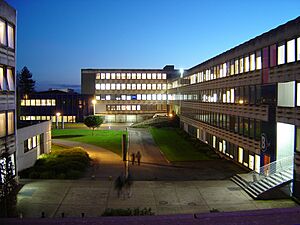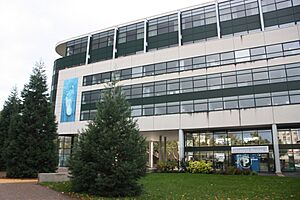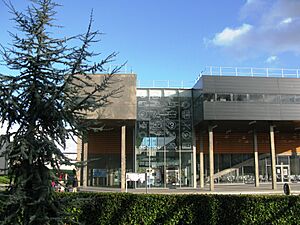Rennes 2 University facts for kids
|
Université Rennes-II Haute-Bretagne
|
|
 |
|
|
Other name
|
Université Rennes 2 |
|---|---|
| Type | Public |
| Established | 1969 |
| Endowment | €106,000,000 |
| President | Vincent Gouëset |
|
Academic staff
|
645 |
|
Administrative staff
|
1,095 |
| Students | 21,445 |
| Undergraduates | 14,145 |
| Postgraduates | 5,183 |
| 478 | |
| Location | , , |
| Campus | Urban |
| Nickname | "Rennes 2 la Rouge" |
| Website | www.univ-rennes2.fr |
Rennes 2 University (also known as UR2 or Université Rennes 2) is a big public university in Upper Brittany, France. It is one of the main universities in the Rennes area. The university's main campus is in the Villejean neighborhood of Rennes. There is also another campus nearby called La Harpe.
Contents
History of Rennes 2 University
How the University Started
The very first university in Brittany was created in Nantes in 1460. This happened because Francis II, Duke of Brittany asked the Pope for it. Students could study arts, medicine, law, and theology there.
Later, in 1728, the mayor of Nantes wanted the university to move to Rennes. Nantes was more focused on trade, while Rennes was home to the Parliament of Brittany. This made Rennes a better place for a school. So, the law school moved to Rennes in 1730.
In 1793, during the French Revolution, the government closed all universities in France. The law school in Rennes reopened in 1806.
Growing in Rennes
In 1808, Napoleon I changed how French universities worked. He created the University of France. Only the Rennes part of the old University of Brittany was included. Nantes had to wait until 1970 to get its university back.
In 1810, a faculty (or department) for letters opened in Rennes. By 1835, it had five schools for different subjects like French literature, history, and philosophy. A science faculty also opened in Rennes in 1840.
These different departments came together in 1885 to form a "Conseil des facultés." In 1896, this group officially became the University of Rennes. At first, the university buildings were spread out across the city. For example, the Faculty of Letters moved to a new building in 1909.
Rennes 2 University is Born
In 1967, a new campus opened in the Villejean area. This campus was made for subjects like arts, literature, and human sciences.
In 1969, new laws helped French universities grow. This led to the University of Rennes splitting into two new universities. One of these became the 'University of Upper Brittany,' which is now Rennes 2 University. At that time, the Villejean area was still developing, so new student housing and other university buildings had to be built.
Today, the Beaulieu area in the east of Rennes has science and philosophy departments. The Villejean campus in the west is home to departments for foreign languages, arts, human sciences, and social sciences. The School of Medicine for University of Rennes 1 is also near the Villejean campus.
Recent Developments
Since March 2002, students can easily reach the Villejean campus by subway. The 'Villejean-Université' station makes travel from the city center very quick.
In 2015, the Robert-Poirier Stadium opened on the Villejean campus. This is a large indoor sports venue that can hold 12,000 people.
On January 1, 2023, Rennes 1 University joined with five other important schools to create the new University of Rennes. Rennes 2 University works closely with this new project, along with other research groups. Together, these institutions have many staff, teachers, researchers, and over 60,000 students.
What You Can Study
Rennes 2 University is organized into five main teaching and research units, called UFRs. This is a common way for public universities in France to be set up.
- UFR of Sports (APS): This unit focuses on sports studies.
- It has one department called STAPS.
- UFR of Arts, Letters, Communication (ALC): This unit covers creative and communication subjects.
- It has five departments: Plastic arts, Performing arts, History of art, Literature, and Music.
- UFR of Foreign Languages: This unit teaches many different languages.
- UFR of Human Science: This unit explores how people think and behave.
- It has three departments: Psychology, Teaching Sciences, and Sociology, Language, and Communication.
- UFR of Social sciences: This unit studies society and how it works.
- It has four departments: Administration économique et sociale (AES), Geography and Spatial Planning, History, and Mathematics applied to Social Sciences (MASS).
Campus Life
Rennes 2 University has a very active campus life with many student groups.
Student Groups
With about 50 student societies, Rennes 2 University has a lot of groups for students to join. There is even a radio station called Radio Campus Rennes. Many of these groups have their spaces in different buildings on campus.
Festivals and Events
Students at Rennes 2 University organize several fun festivals. Some of these have become popular throughout the city.
- "K-barré" focuses on performing arts like theater and dance.
- "Roulements de tambour" is a music festival.
- "Travelling" is a film festival that is now a city-wide event.
- "Tubas d'or" celebrates short movies.
Notable People
Many interesting people have studied or taught at Rennes 2 University.
Alumni (Former Students)
- Louis Le Pensec (born 1937), who was a Minister and a member of the French Parliament.
- Marylise Lebranchu, who served as a Minister of Justice.
- Jean-Yves Le Drian, who was a Minister of Defense.
- Étienne Daho (born 1956), a famous singer.
- Muriel Laporte (born 1963), the lead singer of the rock band Niagara.
- Christophe Honoré (born 1970), a film and theater director and writer.
- Régis Le Bris (born 1975), a football manager and former player.
Faculty (Teachers)
- Jean Delumeau (born 1923), a historian who became a member of the Académie française.
- Dominique Fernandez (born 1929), a writer who won several awards and also became a member of the Académie française.
- Milan Kundera (born 1929), a well-known writer.
- Robert Merle (born 1908), a writer who won the Prix Goncourt.
- Mário Soares (born 1924), who was the President of Portugal.
See also
 In Spanish: Universidad de Rennes 2 Alta Bretaña para niños
In Spanish: Universidad de Rennes 2 Alta Bretaña para niños
- List of public universities in France by academy





